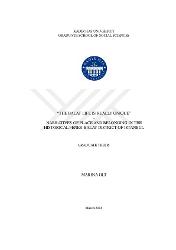| dc.contributor.advisor | Kartarı, Asker | en_US |
| dc.contributor.author | Olt, Marina | |
| dc.date.accessioned | 2019-07-12T08:39:32Z | en_US |
| dc.date.available | 2019-07-12T08:39:32Z | en_US |
| dc.date.issued | 2016 | en_US |
| dc.identifier.uri | https://hdl.handle.net/20.500.12469/2338 | |
| dc.description.abstract | Fener-Balat is one of the oldest districts of istanbul and was home to Greek-Orthodox Christians and Jews for centuries. However in the last century the demographic composition changed fundamentally. After long having been neglected recently the district has received increasing attention especially due to historical housing there. This goes along with a wider interest in istan-bul's past and former minority quarters that emerged within the last decades. Most academic literature about the Fener-Balat district is concerned with is-sues of urban planning or architecture and there seems to be a lack of anthro-pological studies that focus on the personal meanings of places and the narra-tives of the residents living in the district. Thus what seems to be missing here is an anthropological perspective on Fener-Balat as place i.e. as space filled with multiple meanings memories and experiences. Based on ethnographic fieldwork in Fener-Balat this thesis explores the personal place-meanings and examines the ways in which residents of Fener-Balat create meaningful relationships with their local surrounding. Therefore place narratives and be-longing narratives of several residents of the district will be presented and discussed. This will give an insight in the shared and divergent ways in which residents define and describe their neighborhood space and express an at-tachment and belonging to place. | en_US |
| dc.description.abstract | Fener-Balat, Rum-Ortodoks Hıristiyanlarına ve Musevilere ev sahipliği yapmış, İstanbul'un en tarihi semtlerinden biridir. Ancak geçtiğimiz yüzyılda demografik oluşumu tamamıyla değişmiştir. Uzun süre göz ardı edildikten sonra; özellikle de tarihi evlere ev sahipliği yapmasından dolayı son zamanlarda bölgeye gösterilen ilgi artmıştır. Fener-Balat'a gösterilen bu ilgi, aslında son onyıllarda genel olarak İstanbul'un geçmiş azınlık mahallelerine gösterilen ilginin bir parçasıdır. Fener-Balat bölgesiyle ilgili akademik literatürün çoğu, şehir planlaması ve mimarlık gibi konularda olduğu için, literatürde bölgeye antropolojik açıdan yaklaşan ve Fener-Balat bölgesini belleği, deneyimleri ve birden çok anlamı olan bir mekan olarak ele alan çalışmalar pek bulunmamaktadır. Etnografik alan çalışmasına dayanan bu tez, Fener-Balat sakinlerinin mekanla nasıl anlamlı ilişkiler kurduklarını araştırarak, bölgedeki kişisel mekan-anlam ilişkilerini inceler. Bu nedenle bu tezde, bazı Fener-Balat sakinlarinin mekan ve aidiyet anlatıları sunulacak ve tartışılacaktır. Bu araştırma bölge sakinlarinin nasıl ortak ve farklı yollarla mahalle mekanlarını tanımladıklarını açıklayacak ve mekana nasıl aidiyet ve bağlılık duyduklarını gösterecektir. | en_US |
| dc.language.iso | eng | en_US |
| dc.publisher | Kadir Has Üniversitesi | en_US |
| dc.rights | info:eu-repo/semantics/openAccess | en_US |
| dc.subject | Place attachment | en_US |
| dc.subject | Belonging | en_US |
| dc.subject | Neighborhood | en_US |
| dc.subject | Memory | en_US |
| dc.subject | Mekana bağlılık | en_US |
| dc.subject | Aidiyet | en_US |
| dc.subject | Komşuluk | en_US |
| dc.subject | Bellek | en_US |
| dc.title | The Balat life is really unique - narratives of place and belonging in the historical Fener-Balat district of istanbul | en_US |
| dc.type | masterThesis | en_US |
| dc.department | Enstitüler, Lisansüstü Eğitim Enstitüsü, İletişim Çalışmaları Ana Bilim Dalı | en_US |
| dc.relation.publicationcategory | Tez | en_US |
| dc.identifier.yoktezid | 436966 | en_US |
















